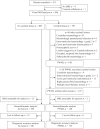Punctate White Matter Lesions Associated With Altered Brain Development And Adverse Motor Outcome In Preterm Infants
- PMID: 29038505
- PMCID: PMC5643493
- DOI: 10.1038/s41598-017-13753-x
Punctate White Matter Lesions Associated With Altered Brain Development And Adverse Motor Outcome In Preterm Infants
Abstract
Preterm infants who develop neurodevelopmental impairment do not always have recognized abnormalities on cerebral ultrasound, a modality routinely used to assess prognosis. In a high proportion of infants, MRI detects punctate white matter lesions that are not seen on ultrasonography. To determine the relation of punctate lesions to brain development and early neurodevelopmental outcome we used multimodal brain MRI to study a large cohort of preterm infants. Punctate lesions without other focal cerebral or cerebellar lesions were detected at term equivalent age in 123 (24.3%) (59 male) of the 506 infants, predominantly in the centrum semiovale and corona radiata. Infants with lesions had higher gestational age, birth weight, and less chronic lung disease. Punctate lesions showed a dose dependent relation to abnormalities in white matter microstructure, assessed with tract-based spatial statistics, and reduced thalamic volume (p < 0.0001), and predicted unfavourable motor outcome at a median (range) corrected age of 20.2 (18.4-26.3) months with sensitivity (95% confidence intervals) 71 (43-88) and specificity 72 (69-77). Punctate white matter lesions without associated cerebral lesions are common in preterm infants currently not regarded as at highest risk for cerebral injury, and are associated with widespread neuroanatomical abnormalities and adverse early neurodevelopmental outcome.
Conflict of interest statement
The authors declare that they have no competing interests.
Figures




References
Publication types
MeSH terms
Grants and funding
LinkOut - more resources
Full Text Sources
Other Literature Sources
Medical

